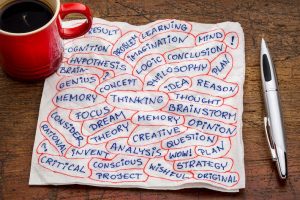
The fundamental disorder of (Asperger’s) individuals is the limitation of their social world.
Social adaptation has to proceed via the intellect. In fact, they have to learn everything via the intellect.
Hans Asperger
Sally and Anne are playing together. Sally has a basket and Anne has a box. Sally puts a marble inside her basket and then goes outside to play. While Sally is away, Anne takes the marble from the basket and puts into her box. When Sally comes back into the room, she wants to play with her marble. Where will she look?
By the time they are five years old most children correctly assume that Sally will look in her basket where she believes it is. Children on the autism spectrum, in contrast, believe that Sally will look in Anne’s box where it really is. Why is this?
By an early age, people typically develop the ability to recognize and understand that other people have their own thoughts, feelings, believes, desires, and intentions. Having this ability enables one to make sense of behavior and predict what other people are going to do next.
Individuals with Autism Spectrum Disorder have difficulty doing this. They are not proficient in recognizing and understanding the cues that indicate what other people are thinking and feeling. Like those who believe Sally will look for her marble in Anne’s box they see things primarily from their own perspective and assume others will do the same.
This ability, or lack thereof, to make inferences about what other people believe to be the case in a given situation is referred to as the theory of mind. It has become perhaps the most well-known explanation of why those with Autism Spectrum Disorder have difficulty communicating and interacting with others in a typical manner. Appreciating this difficulty goes a long way toward comprehending the unusual ways that adults with Autism Spectrum Disorder interact with others.
The Socialization of Adults with Autism Spectrum Disorder
Successful communication depends upon the ability of both participants to infer each other’s intentions. If this inference is not automatic, communicating becomes arduous and a two-way flow of information, ideas, and meaning is significantly compromised.
If people with Autism Spectrum Disorder do not have a theory of mind and are unable to infer what others are thinking and feeling, how then is communication even possible?
It is well established that people with Autism Spectrum Disorder wish to communicate and be part of the social world, unlike those who are severely autistic. One can see this, for example, in how they repetitively talk about their favorite interests or in the frustration they express at lacking friends or spouses.
The desire of those with Autism Spectrum Disorder to interact socially drives their acquisition of social learning. This is why Autism Spectrum Disorder adults have many aspects of socially well-adapted behavior and appear to understand the behavior of others by attributing feelings, beliefs, and intentions to them, yet not have a normally functioning theory of mind.
To paraphrase Hans Asperger, social adaptation has to proceed by pretending one is socially normal. In other words, by acting.
Needless to say, having to figure out how to communicate in everyday situations by relying on past experiences is arduous. Genuine interactive communication is work, and it is for this reason that many people with Autism Spectrum Disorder shy away from social interactions. The laborious effort to communicate also explains why adults with Autism Spectrum Disorder often focus on understanding and accumulating factual information that has no socially relevant content.
The Problem of Theory of Mind
While the theory of mind describes much of the typical behaviors of those with Autism Spectrum Disorder, criticisms of it do exist. One such criticism is the fact that difficulties in understanding how people think and feel are not found in all people with Autism Spectrum Disorder.
Furthermore, people who do not have Autism Spectrum Disorder, but have other conditions, also have trouble “reading” others. One can fail to infer intentions, beliefs, and thoughts about others for different reasons.
Finally, it has been shown that the social impairments of Autism Spectrum Disorder emerge in early life before the ability to imagine the thoughts and feelings of others develops.
Nevertheless, the theory of mind succinctly describes the social and communicative difficulties that are the core features of Autism Spectrum Disorder. For this reason alone, it stands as perhaps the most accepted and powerful explanations of why people with Autism Spectrum Disorder behave as they do.
Read about similar topics here.



